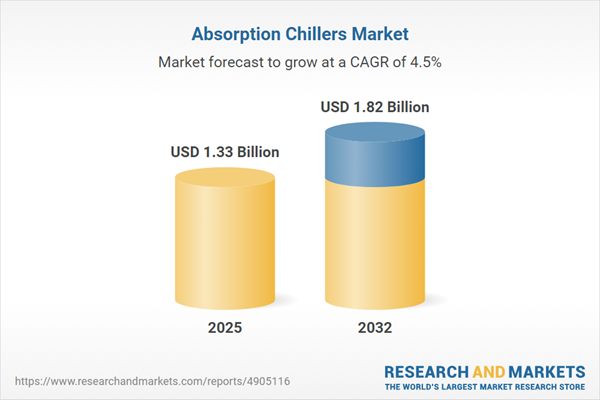Speak directly to the analyst to clarify any post sales queries you may have.
The absorption chillers market is evolving rapidly, as organizations across industries seek efficient and low-emission cooling technologies aligned with global decarbonization strategies. Senior decision-makers recognize the growing importance of innovation, supply chain resilience, and regulatory compliance to remain competitive in this dynamic sector.
Market Snapshot: Absorption Chillers Market Growth and Outlook
The Absorption Chillers Market grew from USD 1.28 billion in 2024 to USD 1.33 billion in 2025. It is expected to continue growing at a CAGR of 4.48%, reaching USD 1.82 billion by 2032. Continued advancements in system efficiency, control technologies, and integration capabilities are driving adoption across industries such as commercial real estate, manufacturing, and energy infrastructure. Companies are increasingly incorporating digital solutions and resource-efficient designs to meet evolving sustainability and operational requirements.
Scope & Segmentation: Comprehensive Market Coverage
- Design Options: Double-effect, single-effect, and triple-effect chillers are engineered to meet varying efficiency and capacity demands in industrial, commercial, and residential environments.
- Power Sources: Choices include direct fired units utilizing natural gas or biogas, indirect fired models connecting with hot water loops, and water-driven systems leveraging geothermal or process-based energy.
- Key Components: Advanced condensers, evaporators, and expansion valves form the backbone of system efficiency, modularity, and maintenance responsiveness.
- Capacity Ranges: Solutions span from units below 100 kW to systems above 500 kW, addressing projects from small retrofits to district-wide cooling networks.
- Applications: Adoption is evident in commercial settings like office buildings and retail, diverse industrial sites including chemical plants and breweries, and a nascent but expanding residential segment focused on solar and off-grid integration.
- Regional Analysis: Coverage includes North America, Latin America, Europe, Middle East, Africa, and Asia-Pacific, each shaped by unique regulatory drivers, energy resources, and infrastructure needs.
- Leading Companies: Market participants analyzed include AGO GmbH Energie + Anlagen, Broad Group, Carrier Corporation, Century Corporation, Colibri BV, EAW Energieanlagenbau GmbH, Ebara Corporation, Heinen & Hopman Engineering BV, Hyundai Climate Control, Johnson Controls, Kawasaki Heavy Industries, Kirloskar Group, LG Corporation, Panasonic Corporation, Robur Corporation, Shuangliang Eco-Energy Systems, Styne Group, Thermax Limited, World Energy, and YAZAKI Corporation.
Key Takeaways: Strategic Insights for Senior Leaders
- Absorption chillers are pivotal in advancing sustainable cooling by utilizing waste heat, solar, and alternative fuels, reducing dependency on traditional compressor-based systems.
- The introduction of digital technologies such as IoT-enabled sensors and remote diagnostics facilitates predictive maintenance and lifecycle optimization, reinforcing operational continuity.
- Market segmentation by design, power source, and capacity enables tailored solutions for efficiency, cost management, and compliance with local regulatory frameworks.
- Innovation in system components and modular design architecture supports faster deployment, reduces downtime, and extends asset lifecycles, crucial for competitive differentiation.
- Strategic collaboration among equipment suppliers, integrators, and financial partners drives market adoption by overcoming barriers linked to capital investment and system complexity.
Tariff Impact: Navigating Trade Dynamics and Supply Chain Pressures
- Recent tariffs imposed by the United States have increased production costs for many manufacturers relying on imported components, requiring shifts in sourcing and procurement strategies.
- Supply chain delays and cost uncertainty have accelerated investments in regional manufacturing hubs, improving resilience and reducing lead times for end users.
- New financing models, including tailored leasing and performance contracts, are being deployed to mitigate price volatility and sustain the investment case for large-scale installations.
- Collaboration between industry associations and policymakers is intensifying to seek relief or exemptions for energy-efficient products, impacting long-term market accessibility.
Methodology & Data Sources
This report integrates extensive secondary research, including industry databases, technical standards, and regulatory publications, with primary interviews from manufacturers, system integrators, end users, and policy experts. Data is validated through triangulation with project records and case studies. Segmentation, scenario planning, and frameworks such as SWOT and Porter’s Five Forces underpin the analysis.
Why This Report Matters
- Enables senior executives to benchmark technology adoption and procurement strategies against peers and best practices.
- Supports data-driven decision-making for investments in sustainable, energy-efficient cooling infrastructures.
- Informs policy navigation and risk mitigation regarding tariffs, supply chain localization, and regulatory incentives.
Conclusion
The absorption chillers market is leveraging advanced technologies and resilient business strategies, establishing a central role in future-ready, low-carbon cooling solutions. Leaders who prioritize innovation and collaborative engagement will be best positioned to navigate and capture emerging market opportunities.
Additional Product Information:
- Purchase of this report includes 1 year online access with quarterly updates.
- This report can be updated on request. Please contact our Customer Experience team using the Ask a Question widget on our website.
Table of Contents
3. Executive Summary
4. Market Overview
7. Cumulative Impact of Artificial Intelligence 2025
Companies Mentioned
The companies profiled in this Absorption Chillers market report include:- AGO GmbH Energie + Anlagen
- Broad Group
- Carrier Corporation
- Century Corporation
- Colibri BV
- EAW Energieanlagenbau GmbH
- Ebara Corporation
- Heinen & Hopman Engineering BV
- Hyundai Climate Control Co. Ltd.
- Johnson Controls International PLC
- Kawasaki Heavy Industries, Ltd
- Kirloskar Group
- LG Corporation
- Panasonic Corporation
- Robur Corporation
- Shuangliang Eco-Energy Systems Co., Ltd.
- Styne Group
- Thermax Limited
- World Energy Co., Ltd.
- YAZAKI Corporation
Table Information
| Report Attribute | Details |
|---|---|
| No. of Pages | 187 |
| Published | November 2025 |
| Forecast Period | 2025 - 2032 |
| Estimated Market Value ( USD | $ 1.33 Billion |
| Forecasted Market Value ( USD | $ 1.82 Billion |
| Compound Annual Growth Rate | 4.4% |
| Regions Covered | Global |
| No. of Companies Mentioned | 21 |









